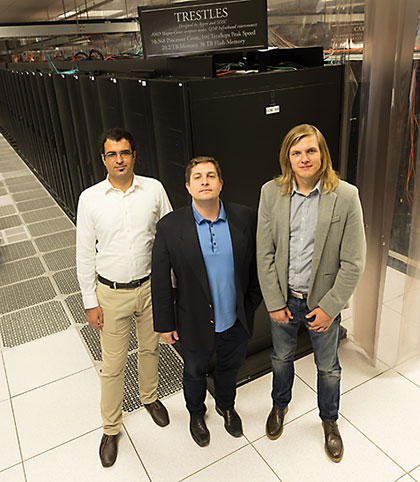

 Skip to navigation
Skip to navigation
Site Primary Navigation:
- About SDSC
- Services
- Support
- Research & Development
- Education & Training
- News & Events
Search The Site:

Published January 16, 2015

Yuri Bazilevs, center, is associate director of CEER and an expert in finite element analysis and isogeometric analysis. He is pictured with postdoctoral researcher Kazem Kamran, left, and Ph.D. student Artem Korobenko, right.
A new center at the UC San Diego Jacobs School of Engineering, focused on developing new ways to protect buildings and infrastructure as well as the human body from extreme events such as blasts from terrorist attacks or high-impact collisions, is joining forces with the university’s San Diego Supercomputer Center (SDSC), to provide data-intensive supercomputer simulations.
Called the Center for Extreme Events Research (CEER), the center brings together a unique combination of experts in experimental and computational research to solve these challenges. As a result, UC San Diego faculty will have the resources to develop sophisticated simulation tools and validate them experimentally.
“We need to be prepared for the next generation of threats,” said J.S. Chen, the center’s director and the William Prager Endowed Chair Professor of Structural Engineering at the Jacobs School of Engineering. “My role is to bring together the fantastic expertise we already have here at UC San Diego, especially in the field of assessment and mitigation of extreme events.”
Yuri Bazilevs, an expert in finite element analysis and isogeometric analysis and an associate director of CEER, is heading the center’s initiatives in the field of computational simulation. His research group focuses on the development of computational methods for large-scale coupled fluid-structure interaction (FSI) problems and their implementation in high-performance computing (HPC) environments.
Bazilevs’ research has ranged from creating detailed simulations of offshore wind turbines in rough sea conditions, to modeling of cardiac assist devices such as blood pumps and prosthetic heart valves. Currently, he is addressing challenges involved in compressible aerodynamics and FSI modeling of gas turbine engines and blast events.
“Systems such as SDSC’s Trestles supercomputer enable simulation of full-scale engineering systems in a much more efficient manner,” said Bazilevs, who used Trestles previously to develop code and run cardiovascular applications. “High-performance computing plays a key role in all the methods and software development, which is in turn essential for CEER’s projects. Having access to thousands of compute cores means we can perform simulations with more sophisticated mechanics modeling and higher temporal and spatial resolution, resulting in greater physical realism and numerical accuracy.”
“CEER is another great example of how SDSC’s advanced computational resources and expertise are finding applications to data-intensive challenges, while fertilizing cross-campus collaborations that are addressing some real-world challenges,” said SDSC Director Michael Norman.
Unique Experimental Facilities
CEER’s mandate means that researchers will cover a wide range of “extreme” events. This includes finding innovative ways to protect buildings, bridges, dams, and the rest of the built infrastructure, as well as finding new ways to protect the human body from events such as blasts or explosions, vehicle crashes, sports collisions and natural disasters such as landslides and earthquakes.
CEER is home to the Extreme Events Simulator, the only facility of its kind in the world. The simulator is capable of replicating everything from blasts generated by car bombs to damage due to hurricane-force winds. The simulator uses the high-speed motion from several actuators – motors driven by a piston-like motion – to replicate the shockwave created by a blast or other type of impact, without a fireball.
For more information on CEER, read the full press release.
About SDSC
As an Organized Research Unit of UC San Diego, SDSC is considered a leader in data-intensive computing and cyberinfrastructure, providing resources, services, and expertise to the national research community, including industry and academia. Cyberinfrastructure refers to an accessible, integrated network of computer-based resources and expertise, focused on accelerating scientific inquiry and discovery. SDSC supports hundreds of multidisciplinary programs spanning a wide variety of domains, from earth sciences and biology to astrophysics, bioinformatics, and health IT. With its two newest supercomputers, Trestles and Gordon, and a new system called Comet to be deployed in 2015, SDSC is a partner in XSEDE (Extreme Science and Engineering Discovery Environment), the most advanced collection of integrated digital resources and services in the world.
Share